Porcelain Insulator News
by Elton Gish
Reprinted from "Crown Jewels of the Wire", November 1992, page 12
Jack Tod published his first book, Porcelain Insulators Guide Book, in 1971.
Since that time, he published several supplements, a second edition, and
finally, a third edition in 1988. Each time there were many new porcelain
insulator styles to add to the U.S. version of the "Universal Style
Chart". This "U-Chart" contains the drawings' for the popular
U-numbers for porcelain insulators that were made in one piece (not cemented).
Since, Jack died in 1989, I have been making the U-Chart drawings, and assigning
U-numbers (with Mrs. Tod's permission) for the new styles that have been
reported from time-to-time. The last four years, since Jack's last edition was
published, has brought still more new porcelain styles. There seems to be no end
to the variety of unipart porcelain. In fact, there are 993 unipart porcelain
styles in Jack's 1988 book. Twenty nine new unipart porcelain insulator styles
have been added to the U-Chart since Jack's last book was published in 1988,
which makes a total of 1022, and that surely isn't all of them either! Many of
the new reported styles are old classic insulators for which few specimens
exist. Most of these new styles have not been reported in "Porcelain
Insulator News", since there has been a lot of activity to report with the
collecting of multipart porcelain insulators. Also, a number of new finds of
rare Fred Locke and threadless insulators have just been made in the last six
months.
With Mrs. Tod' s permission, I have printed a 1992 supplement to Jack
Tod's third edition book, Porcelain Insulators Guide Book. This supplement
contains drawings and estimated values for all 29 of the new unipart porcelain
insulator styles, and the revised drawing of U-922, which was made from a
recently found specimen. One good thing about this supplement is that it has
been designed to be inserted into your third edition book, without having it
hanging out of the edges of your book. It will always be in your book for easy
reference. You may obtain a copy of this four page 1992 U-Chart Supplement by
sending me a large SASE and $1.00. This
is the only way to have all 30 of these drawings at your fingertips for easy
reference.
This month, we will show you a few of these new styles, all of which
have been reported in 1992.

Jerry Turner brought these first two threadless
styles to the Orlando National, so I could make a drawing of them, and for
U-number assignment. The first one is U-972 (see photograph). This insulator has
the ugliest and most crude glaze that I have ever seen. The glaze is very rough
and U-972 -- full of open bubbles. I do not know what color you would call it --
maybe "overcooked brown". Overcooked is really how this insulator
looks.
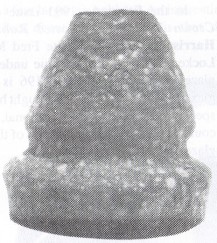
U-972
The next one is U-989 which is a much larger and different version of the
Confederate U-988 slash-top (see the photo on the next page). It has a dull
white glaze. The insulator looks as though it was made out of the same "flintware"
that was used in the Elliots. Note the tie-wire groove at the top. With the
tie-wire in place, the line wire is free to move in the groove. The dished-out areas on either side of the wire groove are apparently intended to
minimize the rubbing of the sagging line wire as it swings in the wind.
Not
shown in the drawing of U-989, is a vertical groove in the pinhole which
intersects the horizontal groove at the top. The horizontal groove at the top of
the pinhole goes a little more than halfway around the top. Apparently, a pin,
with a key-type projection on the end, was used to lock the insulator in place,
by first placing the insulator on the pin and turning it a half turn. This is an
elaborate design which required special pins, and the mounting of those pins in
such an orientation to allow the key mechanism to work. I cannot imagine the
Confederacy going to this extra expense.
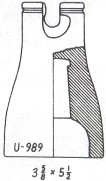
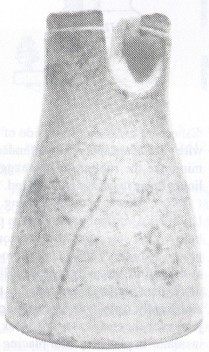
U-989
Jeff Kaminski reported this next new style, U-706A. Jeff's specimen was badly
damaged, but he was excited to find a new marking, not realizing that it was a
new style, too. The 1/4" tall incuse marking, CENTRAL, is boldly stamped on
the side of the crown. The glaze is dark red-brown with light tan edges. It
appears to be a Pittsburg product.
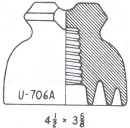
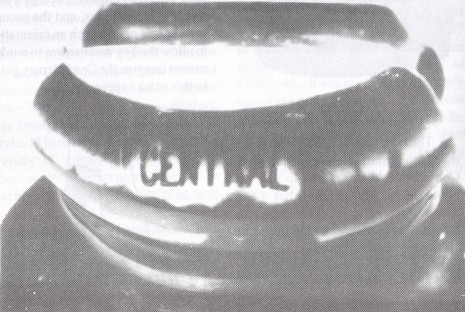
In the February, 1991 issue of Crown Jewels, we reported Robin Harrison's
find of a white Fred M. Locke, U-196. It has the blue underglaze ink marking
#6-3. U-196 is a glazeweld, but when Robin brought his specimen to the Portland
National, I could not determine the location of the glaze weld line.
Mark Lauckner found a damaged U-196. Since it was not a specimen good enough
to display, and with Robin's encouragement, he decided to have it sawed in half
by a lapidary. I want to send a big THANK YOU to Mark for sending me one of the
halves. Now, we know exactly where to put the glazeweld line. My original
drawing needed to be revised anyway. Note that the glazeweld joint exactly
separates the threaded section from the bottom.
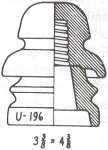
The photograph below shows the
half that Mark sent me. Note that the dark blotch near the top is in the
porcelain surrounding a long air bubble. The porcelain has an almost chalky
appearance, and it is full of tiny air bubbles and a few larger air bubbles. An
interesting fact about this insulator is that the threaded portion of the pinhole has a wider taper than is typical. Only the
top half of the threads fit tightly on the pin, possibly causing the insulator
to wobble on the pin.
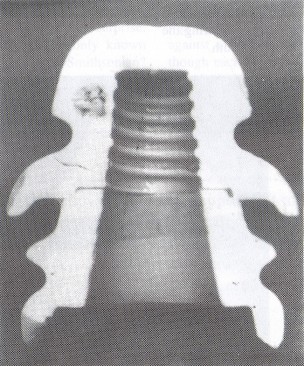
U-196 showing the internal profile
Jim Meyer reported two U-984's. This is a very unusual insulator in that it
is nearly an exact duplicate of the glass CD 127. U-984 is made of pottery
material, similar to most of the threadless "porcelain" insulators
from the 1850's to 1870's. The glaze is a crude dark tan. Jim says that he
bought two of these in a collection. The original owner bought them from a diver
who found them in Mobile Bay in Alabama. They were found around 1970. Jim thinks
that they may be English insulators. He has copies of original bills of lading
that show that the Confederacy imported insulators through an agent that was
based in Bermuda.

Jim says that he also collects bottles and English stoneware,
but the glaze on these insulators looks much different than any English
stoneware that he has seen. Jim suspects that they were Confederate copies of
English stoneware insulators, since the glaze is similar to the stoneware pieces
made during the Civil War period in the South.
Ray Klingensmith sent me a U-987 to look at. This threadless insulator has a
glaze that is identical to U-977 that was reported by Bob Harding in the June,
1991 issue of CJ. The glaze is a bright white with a very crackled surface. I have seen both insulators, and I
believe that these two insulators were made by the same company. Ray's specimen
is very lopsided.
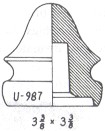
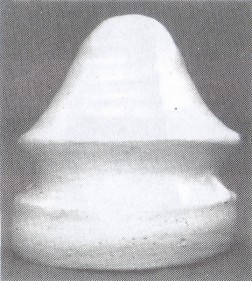
U-987 with a bright white crackled glaze
This is not, by any means, all of the new styles found since
1988, and that have gone unreported in PIN. As a preview of what is upcoming on
these pages of PIN, and in the 1992 supplement, here are a few clues. You can
expect to see five new styles made by Fred M. Locke. One of them, U-957A, is a
two-piece glazeweld. It is a tall version of U-957. U-969 is a white two-piece
Fred Locke glazeweld shaped like M-2335 with an eave and one spout. Another new
style should have been reported in PIN last year, but other reports seem to keep
getting in the way. It is unmarked Pittsburg U-372, which is shaped exactly like
a famous glass Hemingray power piece. No more clues, or we will spoil the
surprise. There is U-978. The only known specimen is owned by the Smithsonian?
Yes, there are even more new styles. How about a Thomas glazeweld only five
inches tall which is much smaller than U-967. Are you scrambling for your back issues of
CJ to find U-967? Do you remember the report of U-966A
with the marking, "New Lexington, O.", or the white Imperial U-933A?
Now, you do not have to dig out the old CJs anymore. Simply order the 1992
Supplement for a preview of all of these new styles.
Bill Rohde and I have a
problem (and a unique solution); namely, we each have one insulator that the
other wants for their collection, but neither of us is willing to trade. To
compound the problem, Bill's M-4600, with "LIMA, N.Y." marking, and my
M-2430, with two Fred M. Locke 7-1 markings (on opposite sides of the top
skirt), are "one-of-a-kind" specimens. I won't say whose idea it was,
but we have decided on a unique way to share these two rare porcelain jewels --
we simply cut them in half with a lapidary saw, and trade the halves! By simply
placing each insulator half with flat side against a mirror, it will now look as
though each of us has a whole specimen!! Now, we can each own two rare
specimens! There is an added benefit with the M-2430, in that each of us can
have a half with the nice #7-1 marking!
|
